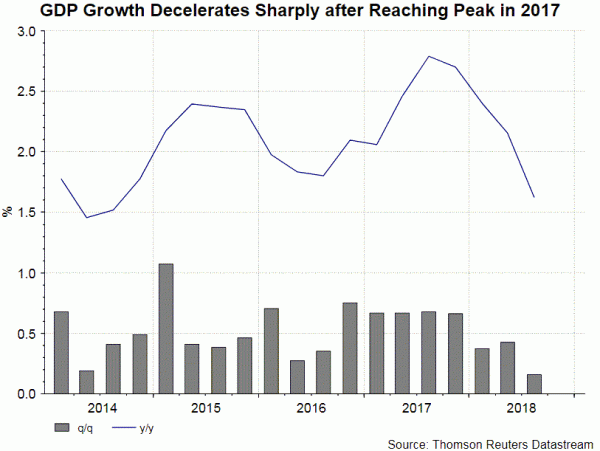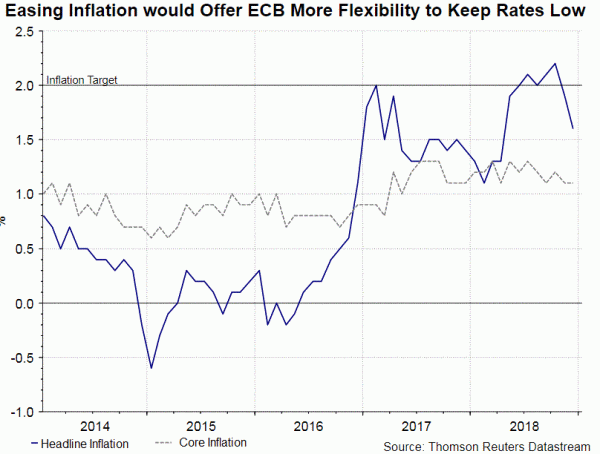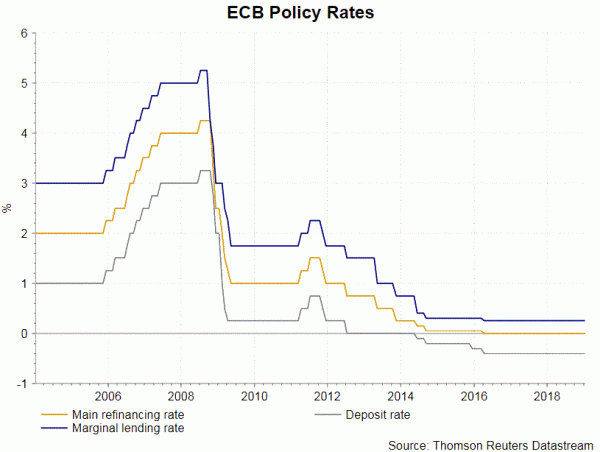GDP growth should have moderated in 4Q18 and would remain lukewarm 1H19. Although the Italian government eventually backed down in the budget plan, political risks in the region have not yet abated. European Parliament election scheduled in mid-May and ongoing uncertainty about Brexit would still cause the euro to trade with high volatility. Growth deceleration and soft inflation allow the ECB to keep interest rates lower for longer. We expect the central bank to leave the policy rates unchanged for the entire year.
Economic Outlook
Economic growth in the Eurozone has peaked in 2017 and the pace of slowdown in 2018 came in faster than expected. GDP growth moderated to the lowest in about four years in the third quarter. GDP growth decelerated to +0.16% q/q in 3Q18, slowest since 2Q14, weighed down by production loss in German car manufacturers. Contractions were seen in Germany and Italy. From a year ago, the economy expanded +1.7%, the lowest level since 4Q14.
The Markit PMI shows that the region experienced the weakest growth in four years last month. the composite index fell -1.6 points to 51.1, the lowest in 4 years and revised from the initial reading of 51.3. although the slowdown was mainly due to the protest in France, the weakness was indeed across the board. Note that the reading for Germany, the largest economy in the bloc, plunged to the lowest level in 5.5 years. Markit suggested that the readings are consistent with GDP growth of “just under 0.3%” in 4Q18. Things are not getting better at the start of 2019. With expectations of output also falling to the lowest in 4 years, firms are not hopeful of recovery in demand any time soon.
Disappointing economic sentiment signals further weakness in 4Q18 and in 2019. European Commission’s economic sentiment indicator dropped to 107.3 in December 2018, from 109.5 in November. This was compared with consensus of 108.2. The top three economies in the region all showed significant decline, with the indices in France, Germany and Italy losing -2 points, -1.9 points and -1.4 points respectively. The consumer confidence index for the region also weakened. The market currently forecasts that GDP growth would be around +0.4% q/q in 4Q18 and 1H19.
Headline inflation eased for two straight months, falling to 8-month low of +1.6% y/y in December. Core CPI steadied at +1% y/y during the month, due to weakness in energy prices. Moderation in the headline reading suggests that a tighter job market has not translated to higher consumption, hence substantiating benign price pressure.
Political Risk
Political risk has not yet abated although the Italian government eventually backed down on the budget plan. For the year ahead, European Parliament elections scheduled in mid-May and ongoing Brexit uncertainty would still result in market volatility. Meanwhile, deterioration in growth outlook the region would likely raise support to right- wing and/ or populist parties across the EU.
ECB Monetary Policy
As indicated in December minutes, the members retained the judgment that risks to growth remained “broadly balanced”. However, it also revealed that some members noted that “a case could be made for assessing risks to activity as tilted to the downside”. The central bank suggested that “the situation remained fragile and fluid, as risks could quickly regain prominence or new uncertainties could emerge”. We see room for ECB to downgrade its growth forecasts. In December, ECB’s updated projections showed that GDP growth would moderate to +1.7% in 2019 (Sep: +1.8%) and stabilize at this level in 2020.
The forward guidance on interest rate reiterated no change in the policy rate “at least through the summer 2019”. The market has gradually pricing out any rate hike this year.
Policy Not Yet Converging to Fed’s
ECB has just ended its entire QE program last December and would begin reinvestment this year. Draghi has been affirming that reinvestment, a process to keep the central bank’s balance sheet as huge as it currently is, would continue “for an extended period of time past the date when it starts raising the key ECB interest rates, and in any case for as long as necessary”. Meanwhile, we expect ECB to announce a new round of targeted long-term refinancing operations (TLTROs) in January. The operations tentatively keep the liquidity ample in the market.
The December FOMC minutes revealed that that Fed has undeniably turned more dovish. Meanwhile, Fed Chair Jerome sent further dovish note last week, noting that he would “not hesitate” to adjust the size of reduction if it causes problems to the financial market. After all, the US and Eurozone are in different stages of the normalization cycle. Our base case remains that the Fed could deliver two rate hikes this year. Both would be implemented in the first half the year. ECB would at most deliver one rate hike in the final quarter of this year. Interest rate differential signals that US dollar should still strengthen against the euro in the first half of the year. Euro might recover in the second half of the year, as a result of the end of the USD bull market and rate hike by ECB.















